The Rank Organisation dominated British cinema throughout the 1930s, 1940s, 1950s and to some extent the 1960s. The British entertainment conglomerate was founded by industrialist J. Arthur Rank in April 1937. It quickly became the largest and most vertically integrated film company in Great Britain, owning production, distribution and exhibition facilities. During the 1940s, the companies Rank controlled produced some of the finest British films of the period. From the 1950s fewer adventurous films were attempted and solidly commercial ventures, largely aimed at the family market, were made instead. Rank diversified into the manufacture of radios, TVs and photocopiers (as one of the owners of Rank Xerox).
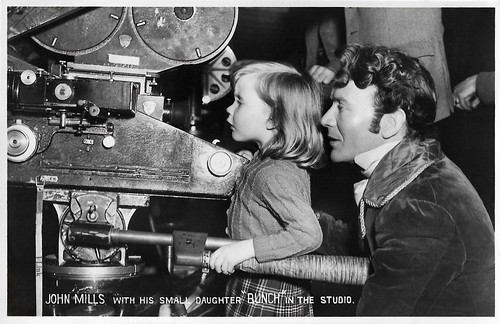
British postcard by Rotary Photo, London, no. F.S. 18. Caption: John Mills with his small daughter 'Bunch' in the studio. The picture was taken during the shooting of Great Expectations (David Lean, 1946). At the time, Juliet Mills (or Bunch) must have been four years old.

British postcard in the Picturegoer Series, London, no. W. 654. Photo: J. Arthur Rank Organisation Ltd. Publicity still for The Red Shoes (Michael Powell, Emeric Pressburger, 1948) with Moira Shearer.
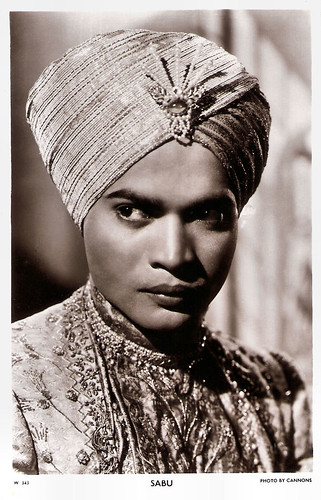
British postcard in the Picturegoer series, London, no. W 343. Photo: Cannons. Publicity still for Black Narcissus (Michael Powell, Emeric Pressburger, 1947) with Sabu.
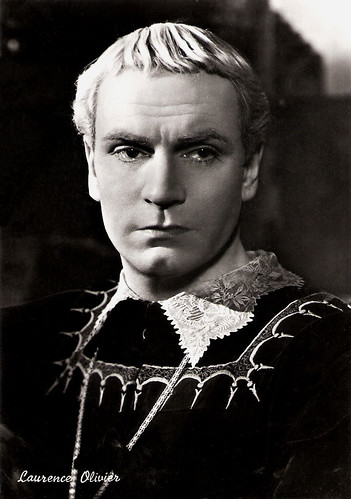
Italian postcard by Bromofoto, Milano, no. 214. Photo: Victory Rank. Publicity still for Hamlet (Laurence Olivier, 1948) with Laurence Olivier.

British postcard in the Picturegoer Series, London, no. D 554. Photo: J. Arthur Rank Organisation. Publicity still for Romeo and Juliet (1954) with Laurence Harvey and Susan Shentall.
Lord J. Arthur Rank, born in Kingston upon Hull, UK, was a wealthy industrialist through his father's flour milling business, Joseph Rank Ltd. He made his somewhat unlikely start in film-making, financing short religious subjects in line with his Methodist beliefs. During the 1920s he had owned a Methodist newspaper, and when he realised the value of films in Sunday school instruction, he entered the film business with British National Pictures in order to improve the quality of these religious films. From these modest origins, the British film company emerged in 1937 as Rank sought to consolidate his film-making interests.
The company logo, the Gongman, was first used in 1935 by the group's distribution company General Film Distributors and seen in the opening titles of the films. Rank originally wanted a wolf to rival the MGM lion, as the opening trademark of his films. The only wolf available was rather mangy-looking. Someone suggested they bang a gong. The gongs used in the famous opening were actually made of papier-mache, and the strongmen like Bombadier Billy Wells simply mimed their strikes. It became a celebrated and enduring film emblem.
J. Arthur Rank had entered the film industry with the intention of making films with strong religious and moral themes, but realised early on that this kind of subject was unlikely to be very profitable. Consequently, Rank went on to make an enormous number of films with a very wide appeal. One of the first Rank films was the comedy Oh, Mr Porter! (Marcel Varnel, 1937) starring Will Hay. It grossed £500,000 at the box office – equal to over £30,000,000 in modern-day money. Oh, Mr Porter! is probably his best-known film to modern audiences. The plot of Oh, Mr Porter was loosely based on the Arnold Ridley play The Ghost Train. It is widely acclaimed as the best of Hay's work, and a classic of its genre. In the following years, Hay made for Rank the comedies Hey! Hey! USA (Marcel Varnel, 1938) and Ask a Policeman (Marcel Varnel, 1939).
The Rank company grew quickly, largely through acquisition. In 1938, the Odeon Cinemas chain was purchased. The chain was started by Oscar Deutsch (ODEON was an acronym for 'Oscar Deutsch Entertains Our Nation'). With builder Charles Boot, Rank bought the grounds of an old Victorian house (Heatherden Hall) in Hertfordshire and turned it into Pinewood Studios. After Alexander Korda ran into financial difficulties, Rank also bought Denham Studios. These were merged with the facilities at Pinewood and the Amalgamated Studios in Borehamwood were acquired, but not used for making films. Also in 1939, the British sites of Paramount Cinemas were purchased. Two years later followed the purchase of the Gaumont-British Picture Corporation, which also owned Gainsborough Pictures, 251 cinemas and the Lime Grove Studios.
During the Second World War, Rank produced the patriotic war film In Which We Serve (Noël Coward, David Lean, 1942). It was made with the assistance of the Ministry of Information. The screenplay by Noël Coward was inspired by the exploits of Captain Lord Louis Mountbatten, who was in command of the destroyer HMS Kelly when it was sunk during the Battle of Crete. Coward composed the film's music as well as starring in the film as the ship's captain. The film also starred John Mills, Bernard Miles, Celia Johnson and Richard Attenborough in his first screen role. The film was the second most popular movie at the British box office in 1943, and remains a classic example of wartime British cinema through its patriotic imagery of national unity and social cohesion within the context of the war.
In 1944, Rank produced the Technicolor film adaptation of William Shakespeare's play Henry V (1944). It stars Laurence Olivier, who also directed. The film begins as a recreation of a stage production of the play in the Globe Theatre, then gradually turns into a stylised cinematic rendition of the play, with sets reminiscent of a medieval Book of Hours. Henry V was intended as a morale booster for Britain, and partly funded by the British government. The film won Olivier an Academy Honorary Award for "his Outstanding achievement as actor, producer and director in bringing Henry V to the screen." It was the first Shakespeare film to be both critically and commercially successful.
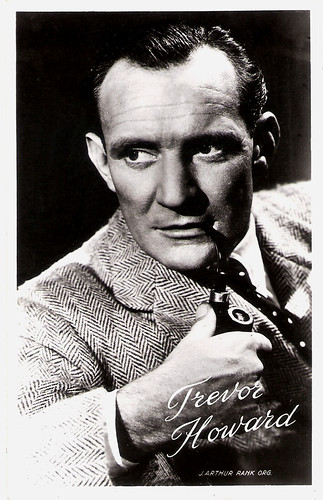
Trevor Howard. Dutch postcard, no. AX 289. Photo: Cornel Lucas / J. Arthur Rank Organisation.
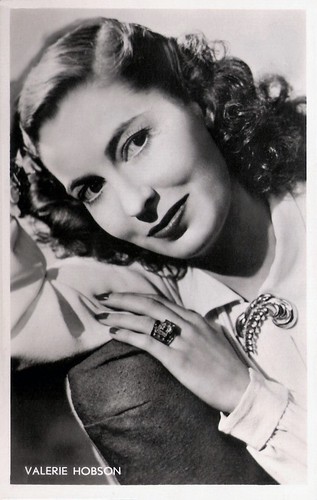
Valerie Hobson. Dutch postcard. Photo: J. Arthur Rank.
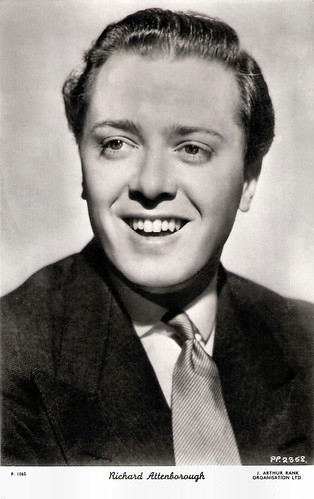
Richard Attenborough. British postcard by Show Parade Picture Service, London, in the series 'The People', no. P1065. Photo: J. Arthur Rank Organisation Ltd.
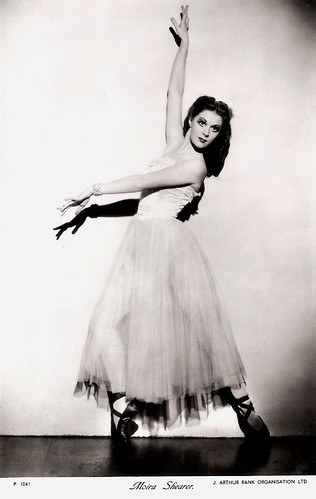
Moira Shearer. British postcard by 'The People' Show Parade Picture Service, London, no. P. 1041. Photo: J. Arthur Rank Organisation Ltd.
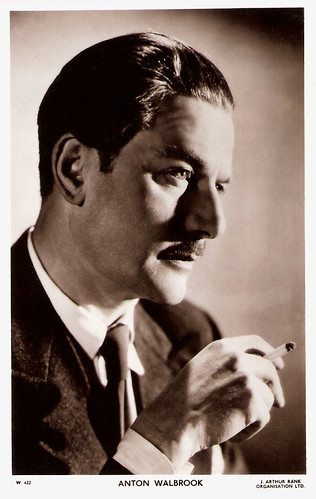
Anton Walbrook. British postcard in the Picturegoer Series, London, no. W. 432. Photo: J. Arthur Rank Organization Ltd.
One of the best things about filmmaking for Rank was the freedom given to talented directors that allowed them to make some of the most successful and spectacular films ever made in Britain. After the war, a loose collective of film makers was established under the banner of Independent Producers Ltd. In 1945, Michael Powell and Emeric Pressburger made the romance I Know Where I'm Going! starring Wendy Hiller and Roger Livesey, David Lean directed the romantic drama Brief Encounter (1945) about British suburban life on the eve of World War 2, with Trevor Howard and Celia Johnson. In the next year followed two more classics, Great Expectations (David Lean, 1946), based on the novel by Charles Dickens and starring John Mills, and the fantasy-romance A Matter of Life and Death (Michael Powell, Emeric Pressburger, 1946), set in England during the Second World War, and starring David Niven.
In the following years, Independent Producers delivered more classics like Black Narcissus (Michael Powell, Emeric Pressburger, 1947) with Deborah Kerr, Jean Simmons and Sabu, and The Red Shoes (Michael Powell, Emeric Pressburger, 1948), with Moira Shearer and Anton Walbrook. The duo Frank Launder and Sidney Gilliat came with the spy film I See a Dark Stranger (1946) and the comedy The Happiest Days of Your Life) (1950) with Alastair Sim and Margaret Rutherford. Ken Annakin made the comedy Holiday Camp (1947) with Flora Robson, and Muriel Box directed the melodrama The Seventh Veil (1945) with James Mason and Ann Todd.
In the mid-1940s Two Cities Films became part of the Rank Organisation producing key films such as the Film Noir Odd Man Out (Carol Reed, 1947) featuring James Mason, Hamlet (Laurence Olivier, 1948), the comedy Vice Versa (Peter Ustinov, 1948) and the fantasy The Rocking Horse Winner (Anthony Pelissier, 1949). In 1946, Rank bought for £1 million+ a 50 per cent share in a chain of 133 cinemas from New Zealander Robert James Kerridge, the biggest exhibition chain in Australasia; it was renamed Kerridge Odeon. In the late 1940s, a majority shareholding in Allied Cinemas and Irish Cinemas Ltd was gained, thus becoming the largest exhibition circuit in Ireland. Rank maintained this position maintained until the early 1980s.
So by the late 1940s J Arthur Rank (or the Rank Organisation as it was now called), owned five major film studio complexes, Pinewood Film Studios, Denham Film Studios, Ealing Studios, Lime Grove Studios and Islington Studios. (The studios at Lime Grove were sold to the BBC in 1949.) Rank owned 650 UK cinemas (the Odeon, Gaumont and Paramount chains) plus various international holdings, including subsidiaries in Canada and The Netherlands, and General Film Distributors (later Rank Film Distributors), including the UK distribution rights to Universal Pictures.
In 1945, the Company of Youth, the Rank Organisation acting school often referred to as 'The Charm School, was founded. It launched several careers including those of Donald Sinden, Dirk Bogarde, Diana Dors and Christopher Lee. Although she was not a member of the school, Petula Clark was under contract to Rank for a period of time and starred in a number of films released by the studio, including London Town (Wesley Ruggles, 1946), one of the costliest flops in British film history. Also under contract to Rank was the Canadian actor Philip Gilbert.
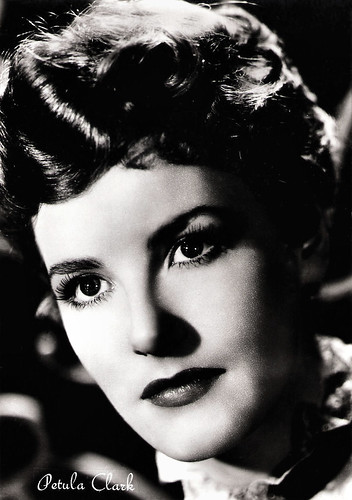
Petula Clark. Italian postcard by Rotalfoto, Milano, no. 129. Photo: Rank Film. Publicity still for The Card (Ronald Neame, 1952).
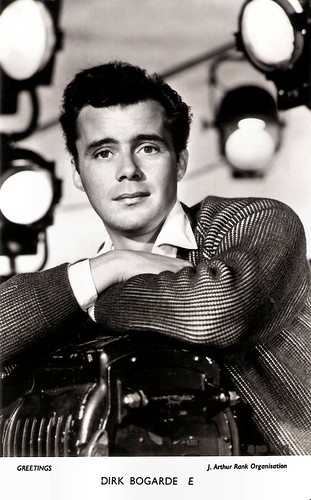
Dirk Bogarde. British Greetings card, no. E. Photo: J. Arthur Rank Organisation.
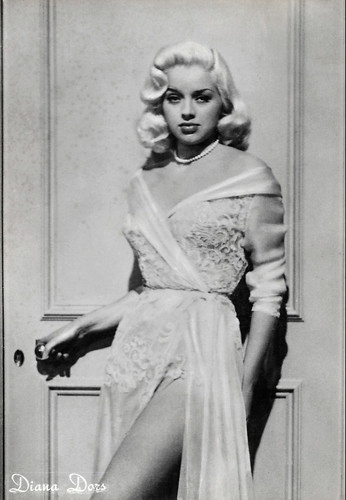
Diana Dors. Italian postcard by Rotalfoto, Milano, no. 536. Photo: Rank.
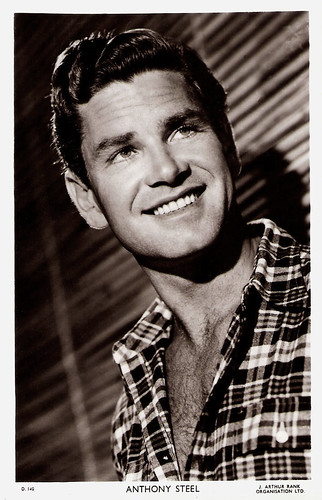
Anthony Steel. British postcard in the Picturegoer Series, London, no. D 140. Photo: J. Arthur Rank Organisation.
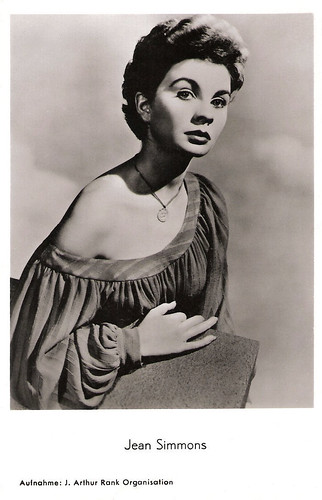
Jean Simmons. German postcard by F.J. Rüdel Filmpostkartenverlag, Hamburg-Bergedorf, no. 115. Photo: J. Arthur Rank Organisation.
Despite backing some excellent films, Rank was in crisis by 1949. An over-ambitious attempt to expand into America had brought Rank to near bankruptcy. He had built up a debt of £16 million, and the studio reported an annual loss of £3.5 million. Managing Director John Davis cut staff, reduced budgets and concentrated film production at Pinewood. Other studio facilities (in Islington) were closed, sold (Lime Grove Studios) or leased (Denham). The Rank Organisation closed Independent Producers Ltd. The policies of Davis alienated many in the industry, in particular they led film director David Lean, responsible for some of Rank's most critically and financially successful films, to look elsewhere for backing.
In 1949, the company bought the Bush Radio manufacturing facility and began to diversify its interests. In the early 1960s Rank took over Murphy Radio to form the Rank Bush Murphy Group which was eventually sold to Great Universal Stores in 1978. In 1956 Rank began a partnership with the Haloid Corporation to form Rank Xerox. Rank was also a significant shareholder in the consortium which became Southern Television, the first ITV television contract holder for the south of England. In the late 1950s, Rank set up Rank Records Ltd. (the record label was named Top Rank) and Jaro Records (a US subsidiary). In 1960, Top Rank was taken over by EMI, and in 1962 they replaced it with Stateside Records. Top Rank artists included Gary U.S. Bonds, the Shirelles, B. Bumble and the Stingers, and John Leyton.
From the 1950s, fewer adventurous films were produced and solidly commercial ventures, largely aimed at the family market, were made instead. These include the popular Norman Wisdom comedies, the Doctor films series with Dirk Bogarde. and, later, Rank took on the Carry On film series. However some films of note were produced during this era including The Browning Version (Anthony Asquith, 1951), the comedy Genevieve (Henry Cornelius, 1953) and Reach for the Sky (Lewis Gilbert, 1956), as well as a clutch of prestige topics such as the Coronation of Queen Elizabeth II and filmed performances by the Royal Ballet.
During the 1950s the British photographer Cornel Lucas set up the Pool Studio at Pinewood where he photographed many of the film stars of this era of cinema, such as Diana Dors, Marlene Dietrich, David Niven and Lucas' wife Belinda Lee.
J. Arthur Rank had stepped down as managing director of the Rank Organisation in 1952, but remained as chairman until 1962. In 1960, Rank Audio Visual was created, bringing together Rank's acquisitions in multimedia, including Bell & Howell (acquired with Gaumont British in 1941), Andrew Smith Harkness Ltd (1952) and Wharfedale Ltd (1958). Subsequent acquisitions included Strand Electric Holdings (1968) and H.J. Leak & Co. (1969). In the mid and late 1970s, Rank Audio Visual made a 3-in-1 stereo music centre, as well as TV sets in conjunction with NEC of Japan. The production of the 'classic' Rank TV ran in the mid to late 70s, some interim models appeared and the 'modern' Rank TV appeared in the early 1980s.

Susan Shaw. Dutch postcard, no. AX 495. Photo: J. Arthur Rank Organisation.
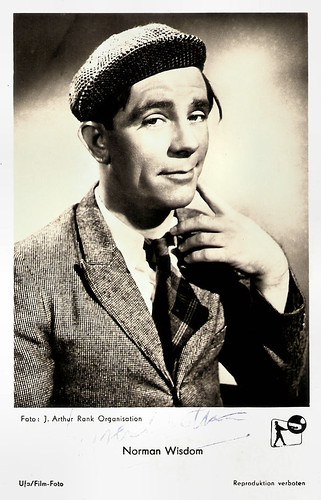
Norman Wisdom. German postcard by Ufa, Berlin-Tempelhof, no. FK 988. Photo: J. Arthur Rank Organisation. Publicity still for Trouble in Store (John Paddy Carstairs, 1953).
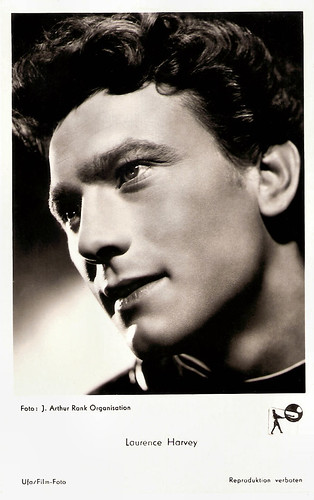
Laurence Harvey. German postcard by Ufa, Berlin-Tempelhof, no. FK 1322. Photo: J. Arthur Rank Organisation. Publicity still for Romeo and Juliet (1954).
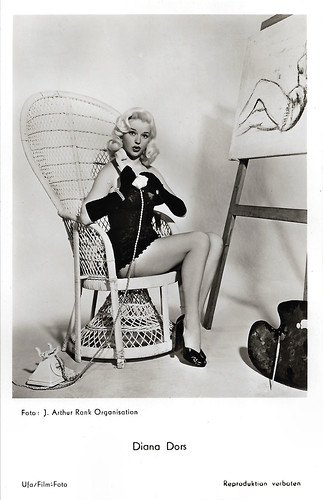
Diana Dors German postcard by Ufa, Berlin-Tempelhof, no. FK 2061. Photo: J. Arthur Rank Organisation.
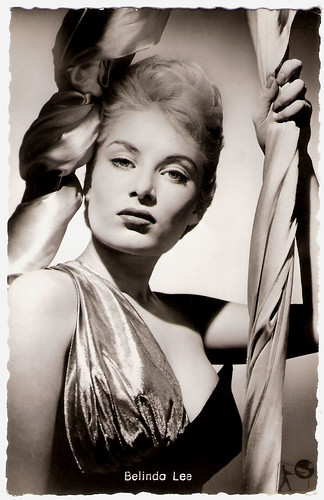
Belinda Lee. German postcard by Kolibri-Verlag G.m.b.H, Minden/Westf., no. 2720. Photo: Cornel Lucas / J. Arhur Rank Organisation.
In 1960, John Davis announced that Rank would concentrate on bigger budgeted, internationally focused productions. In 1961 they announced a production slate of a dozen films worth £7 million. From 1959 to 1969: the company made over 500 weekly short cinema films in a series entitled Look At Life, each film depicting an area of British life. Unfortunately, Rank failed to invest in television when the medium was becoming increasingly popular and cinema audiences were declining.
A highlight of the Rank film production during the 1960s was the espionage film The Ipcress File (Sidney J. Furie, 1965) starring Michael Caine. The screenplay, by Bill Canaway and James Doran, was based on Len Deighton's novel, The IPCRESS File (1962). It received a BAFTA award for the Best British film released in 1965. This film and its sequels were a deliberately downbeat alternative to the hugely successful James Bond films, even though one of the Bond producers, Harry Saltzman, was involved with the Harry Palmer series, along with other personnel who had been contracted to work on one or more of the 007 movies.
From 1971 to 1976 Rank only invested around £1.5 million a year in film production. According to executive Tony Williams "the two main streams that they were down to was Carry On pictures and horror films made by Kevin Francis". However, in 1976 Rank enjoyed much success with Bugsy Malone (Alan Parker, 1976) which they co-produced with Paramount Pictures. It features only child actors with Scott Baio and Jodie Foster in pivotal roles. This success encouraged Rank to re-enter film production.
In 1977 Rank appointed Tony Williams head of production and over two years Rank made eight films worth £10 million, including the horror film The Shout (Jerzy Skolimowski, 1978), the thriller The Thirty Nine Steps (Don Sharp, 1978), and the spy thriller Riddle of the Sands (Tony Maylam, 1979) with Michael York. One of the more interesting productions was psychological thriller Bad timing (Nicolas Roeg, 1980), starring Art Garfunkel and Theresa Russell. Many of these stories were set in the past. Few of these new Rank films performed well at the box office, losing £1.6 million over all. (The company's pre-tax profit was £131 million.)
At the Cannes Film Festival in 1980 Ed Chilton of Rank announced a £12 million slate of projects. However, by June they withdrew from production once again. Rank's final production was the motorracing film Silver Dream Racer (1980) starring British pop star David Essex. The Rank films that had been announced for production were cancelled. After a time Rank Film Distributors was in trouble because they hadn’t got any new product. They did an output deal with Orion.
In 1995, the Rank Group acquired all the outstanding shares of the Rank Organisation. In spring 1997, Rank sold Rank Film Distributors, including its library of 749 films, to Carlton Television for £65 million and immediately became known as Carlton/RFD Ltd. Pinewood Studios and Odeon Cinemas were both sold off in 2000. The company finally severed its remainings connection with the film industry in 2005 when it sold its DVD distribution business and Deluxe technical support unit.
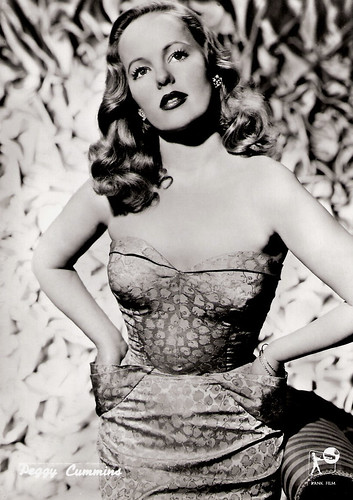
Peggy Cummins. Italian postcard by Bromofoto, Milano, no. 673. Photo: Rank Film.
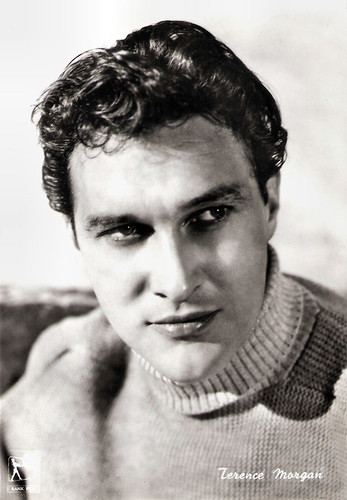
Terence Morgan. Italian postcard by Bromofoto, Milano, no. 1004. Photo: Rank Film. Publicity still for Dance Little Lady (Val Guest, 1954).
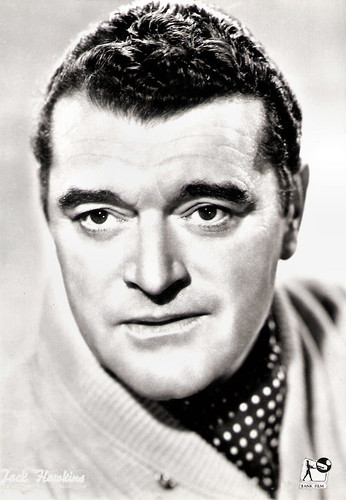
Jack Hawkins. Italian postcard by Bromofoto, Milano, no. 1288. Photo: Rank Film. Publicity still for The Long Arm (Charles Frend, 1956).
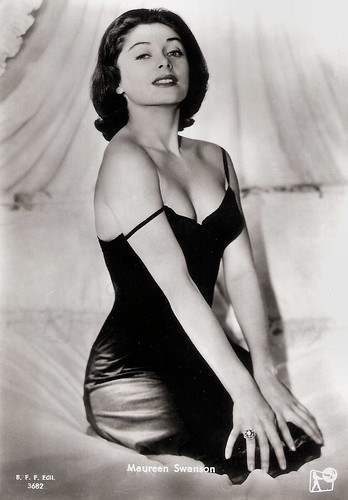
Maureen Swanson. Italian postcard by B.F.F. Edit., no. 3682. Photo: Rank Organisation. Publicity still for Robbery Under Arms (Jack Lee, 1957).

Anne Heywood. Italian postcard by Bromofoto, Milano, no 1498. Photo: Rank. Publicity still for Floods of Fear (Charles Crichton, 1958).
Sources: Lou Alexander (BFI Screenonline), Wikipedia and IMDb.

British postcard by Rotary Photo, London, no. F.S. 18. Caption: John Mills with his small daughter 'Bunch' in the studio. The picture was taken during the shooting of Great Expectations (David Lean, 1946). At the time, Juliet Mills (or Bunch) must have been four years old.

British postcard in the Picturegoer Series, London, no. W. 654. Photo: J. Arthur Rank Organisation Ltd. Publicity still for The Red Shoes (Michael Powell, Emeric Pressburger, 1948) with Moira Shearer.

British postcard in the Picturegoer series, London, no. W 343. Photo: Cannons. Publicity still for Black Narcissus (Michael Powell, Emeric Pressburger, 1947) with Sabu.

Italian postcard by Bromofoto, Milano, no. 214. Photo: Victory Rank. Publicity still for Hamlet (Laurence Olivier, 1948) with Laurence Olivier.

British postcard in the Picturegoer Series, London, no. D 554. Photo: J. Arthur Rank Organisation. Publicity still for Romeo and Juliet (1954) with Laurence Harvey and Susan Shentall.
A Methodist Millionaire spreading the Gospel through Films
Lord J. Arthur Rank, born in Kingston upon Hull, UK, was a wealthy industrialist through his father's flour milling business, Joseph Rank Ltd. He made his somewhat unlikely start in film-making, financing short religious subjects in line with his Methodist beliefs. During the 1920s he had owned a Methodist newspaper, and when he realised the value of films in Sunday school instruction, he entered the film business with British National Pictures in order to improve the quality of these religious films. From these modest origins, the British film company emerged in 1937 as Rank sought to consolidate his film-making interests.
The company logo, the Gongman, was first used in 1935 by the group's distribution company General Film Distributors and seen in the opening titles of the films. Rank originally wanted a wolf to rival the MGM lion, as the opening trademark of his films. The only wolf available was rather mangy-looking. Someone suggested they bang a gong. The gongs used in the famous opening were actually made of papier-mache, and the strongmen like Bombadier Billy Wells simply mimed their strikes. It became a celebrated and enduring film emblem.
J. Arthur Rank had entered the film industry with the intention of making films with strong religious and moral themes, but realised early on that this kind of subject was unlikely to be very profitable. Consequently, Rank went on to make an enormous number of films with a very wide appeal. One of the first Rank films was the comedy Oh, Mr Porter! (Marcel Varnel, 1937) starring Will Hay. It grossed £500,000 at the box office – equal to over £30,000,000 in modern-day money. Oh, Mr Porter! is probably his best-known film to modern audiences. The plot of Oh, Mr Porter was loosely based on the Arnold Ridley play The Ghost Train. It is widely acclaimed as the best of Hay's work, and a classic of its genre. In the following years, Hay made for Rank the comedies Hey! Hey! USA (Marcel Varnel, 1938) and Ask a Policeman (Marcel Varnel, 1939).
The Rank company grew quickly, largely through acquisition. In 1938, the Odeon Cinemas chain was purchased. The chain was started by Oscar Deutsch (ODEON was an acronym for 'Oscar Deutsch Entertains Our Nation'). With builder Charles Boot, Rank bought the grounds of an old Victorian house (Heatherden Hall) in Hertfordshire and turned it into Pinewood Studios. After Alexander Korda ran into financial difficulties, Rank also bought Denham Studios. These were merged with the facilities at Pinewood and the Amalgamated Studios in Borehamwood were acquired, but not used for making films. Also in 1939, the British sites of Paramount Cinemas were purchased. Two years later followed the purchase of the Gaumont-British Picture Corporation, which also owned Gainsborough Pictures, 251 cinemas and the Lime Grove Studios.
During the Second World War, Rank produced the patriotic war film In Which We Serve (Noël Coward, David Lean, 1942). It was made with the assistance of the Ministry of Information. The screenplay by Noël Coward was inspired by the exploits of Captain Lord Louis Mountbatten, who was in command of the destroyer HMS Kelly when it was sunk during the Battle of Crete. Coward composed the film's music as well as starring in the film as the ship's captain. The film also starred John Mills, Bernard Miles, Celia Johnson and Richard Attenborough in his first screen role. The film was the second most popular movie at the British box office in 1943, and remains a classic example of wartime British cinema through its patriotic imagery of national unity and social cohesion within the context of the war.
In 1944, Rank produced the Technicolor film adaptation of William Shakespeare's play Henry V (1944). It stars Laurence Olivier, who also directed. The film begins as a recreation of a stage production of the play in the Globe Theatre, then gradually turns into a stylised cinematic rendition of the play, with sets reminiscent of a medieval Book of Hours. Henry V was intended as a morale booster for Britain, and partly funded by the British government. The film won Olivier an Academy Honorary Award for "his Outstanding achievement as actor, producer and director in bringing Henry V to the screen." It was the first Shakespeare film to be both critically and commercially successful.

Trevor Howard. Dutch postcard, no. AX 289. Photo: Cornel Lucas / J. Arthur Rank Organisation.

Valerie Hobson. Dutch postcard. Photo: J. Arthur Rank.

Richard Attenborough. British postcard by Show Parade Picture Service, London, in the series 'The People', no. P1065. Photo: J. Arthur Rank Organisation Ltd.

Moira Shearer. British postcard by 'The People' Show Parade Picture Service, London, no. P. 1041. Photo: J. Arthur Rank Organisation Ltd.

Anton Walbrook. British postcard in the Picturegoer Series, London, no. W. 432. Photo: J. Arthur Rank Organization Ltd.
The Classics of the Independent Producers
One of the best things about filmmaking for Rank was the freedom given to talented directors that allowed them to make some of the most successful and spectacular films ever made in Britain. After the war, a loose collective of film makers was established under the banner of Independent Producers Ltd. In 1945, Michael Powell and Emeric Pressburger made the romance I Know Where I'm Going! starring Wendy Hiller and Roger Livesey, David Lean directed the romantic drama Brief Encounter (1945) about British suburban life on the eve of World War 2, with Trevor Howard and Celia Johnson. In the next year followed two more classics, Great Expectations (David Lean, 1946), based on the novel by Charles Dickens and starring John Mills, and the fantasy-romance A Matter of Life and Death (Michael Powell, Emeric Pressburger, 1946), set in England during the Second World War, and starring David Niven.
In the following years, Independent Producers delivered more classics like Black Narcissus (Michael Powell, Emeric Pressburger, 1947) with Deborah Kerr, Jean Simmons and Sabu, and The Red Shoes (Michael Powell, Emeric Pressburger, 1948), with Moira Shearer and Anton Walbrook. The duo Frank Launder and Sidney Gilliat came with the spy film I See a Dark Stranger (1946) and the comedy The Happiest Days of Your Life) (1950) with Alastair Sim and Margaret Rutherford. Ken Annakin made the comedy Holiday Camp (1947) with Flora Robson, and Muriel Box directed the melodrama The Seventh Veil (1945) with James Mason and Ann Todd.
In the mid-1940s Two Cities Films became part of the Rank Organisation producing key films such as the Film Noir Odd Man Out (Carol Reed, 1947) featuring James Mason, Hamlet (Laurence Olivier, 1948), the comedy Vice Versa (Peter Ustinov, 1948) and the fantasy The Rocking Horse Winner (Anthony Pelissier, 1949). In 1946, Rank bought for £1 million+ a 50 per cent share in a chain of 133 cinemas from New Zealander Robert James Kerridge, the biggest exhibition chain in Australasia; it was renamed Kerridge Odeon. In the late 1940s, a majority shareholding in Allied Cinemas and Irish Cinemas Ltd was gained, thus becoming the largest exhibition circuit in Ireland. Rank maintained this position maintained until the early 1980s.
So by the late 1940s J Arthur Rank (or the Rank Organisation as it was now called), owned five major film studio complexes, Pinewood Film Studios, Denham Film Studios, Ealing Studios, Lime Grove Studios and Islington Studios. (The studios at Lime Grove were sold to the BBC in 1949.) Rank owned 650 UK cinemas (the Odeon, Gaumont and Paramount chains) plus various international holdings, including subsidiaries in Canada and The Netherlands, and General Film Distributors (later Rank Film Distributors), including the UK distribution rights to Universal Pictures.
In 1945, the Company of Youth, the Rank Organisation acting school often referred to as 'The Charm School, was founded. It launched several careers including those of Donald Sinden, Dirk Bogarde, Diana Dors and Christopher Lee. Although she was not a member of the school, Petula Clark was under contract to Rank for a period of time and starred in a number of films released by the studio, including London Town (Wesley Ruggles, 1946), one of the costliest flops in British film history. Also under contract to Rank was the Canadian actor Philip Gilbert.

Petula Clark. Italian postcard by Rotalfoto, Milano, no. 129. Photo: Rank Film. Publicity still for The Card (Ronald Neame, 1952).

Dirk Bogarde. British Greetings card, no. E. Photo: J. Arthur Rank Organisation.

Diana Dors. Italian postcard by Rotalfoto, Milano, no. 536. Photo: Rank.

Anthony Steel. British postcard in the Picturegoer Series, London, no. D 140. Photo: J. Arthur Rank Organisation.

Jean Simmons. German postcard by F.J. Rüdel Filmpostkartenverlag, Hamburg-Bergedorf, no. 115. Photo: J. Arthur Rank Organisation.
Aiming at the family market
Despite backing some excellent films, Rank was in crisis by 1949. An over-ambitious attempt to expand into America had brought Rank to near bankruptcy. He had built up a debt of £16 million, and the studio reported an annual loss of £3.5 million. Managing Director John Davis cut staff, reduced budgets and concentrated film production at Pinewood. Other studio facilities (in Islington) were closed, sold (Lime Grove Studios) or leased (Denham). The Rank Organisation closed Independent Producers Ltd. The policies of Davis alienated many in the industry, in particular they led film director David Lean, responsible for some of Rank's most critically and financially successful films, to look elsewhere for backing.
In 1949, the company bought the Bush Radio manufacturing facility and began to diversify its interests. In the early 1960s Rank took over Murphy Radio to form the Rank Bush Murphy Group which was eventually sold to Great Universal Stores in 1978. In 1956 Rank began a partnership with the Haloid Corporation to form Rank Xerox. Rank was also a significant shareholder in the consortium which became Southern Television, the first ITV television contract holder for the south of England. In the late 1950s, Rank set up Rank Records Ltd. (the record label was named Top Rank) and Jaro Records (a US subsidiary). In 1960, Top Rank was taken over by EMI, and in 1962 they replaced it with Stateside Records. Top Rank artists included Gary U.S. Bonds, the Shirelles, B. Bumble and the Stingers, and John Leyton.
From the 1950s, fewer adventurous films were produced and solidly commercial ventures, largely aimed at the family market, were made instead. These include the popular Norman Wisdom comedies, the Doctor films series with Dirk Bogarde. and, later, Rank took on the Carry On film series. However some films of note were produced during this era including The Browning Version (Anthony Asquith, 1951), the comedy Genevieve (Henry Cornelius, 1953) and Reach for the Sky (Lewis Gilbert, 1956), as well as a clutch of prestige topics such as the Coronation of Queen Elizabeth II and filmed performances by the Royal Ballet.
During the 1950s the British photographer Cornel Lucas set up the Pool Studio at Pinewood where he photographed many of the film stars of this era of cinema, such as Diana Dors, Marlene Dietrich, David Niven and Lucas' wife Belinda Lee.
J. Arthur Rank had stepped down as managing director of the Rank Organisation in 1952, but remained as chairman until 1962. In 1960, Rank Audio Visual was created, bringing together Rank's acquisitions in multimedia, including Bell & Howell (acquired with Gaumont British in 1941), Andrew Smith Harkness Ltd (1952) and Wharfedale Ltd (1958). Subsequent acquisitions included Strand Electric Holdings (1968) and H.J. Leak & Co. (1969). In the mid and late 1970s, Rank Audio Visual made a 3-in-1 stereo music centre, as well as TV sets in conjunction with NEC of Japan. The production of the 'classic' Rank TV ran in the mid to late 70s, some interim models appeared and the 'modern' Rank TV appeared in the early 1980s.

Susan Shaw. Dutch postcard, no. AX 495. Photo: J. Arthur Rank Organisation.

Norman Wisdom. German postcard by Ufa, Berlin-Tempelhof, no. FK 988. Photo: J. Arthur Rank Organisation. Publicity still for Trouble in Store (John Paddy Carstairs, 1953).

Laurence Harvey. German postcard by Ufa, Berlin-Tempelhof, no. FK 1322. Photo: J. Arthur Rank Organisation. Publicity still for Romeo and Juliet (1954).

Diana Dors German postcard by Ufa, Berlin-Tempelhof, no. FK 2061. Photo: J. Arthur Rank Organisation.

Belinda Lee. German postcard by Kolibri-Verlag G.m.b.H, Minden/Westf., no. 2720. Photo: Cornel Lucas / J. Arhur Rank Organisation.
A deliberately downbeat alternative to 007
In 1960, John Davis announced that Rank would concentrate on bigger budgeted, internationally focused productions. In 1961 they announced a production slate of a dozen films worth £7 million. From 1959 to 1969: the company made over 500 weekly short cinema films in a series entitled Look At Life, each film depicting an area of British life. Unfortunately, Rank failed to invest in television when the medium was becoming increasingly popular and cinema audiences were declining.
A highlight of the Rank film production during the 1960s was the espionage film The Ipcress File (Sidney J. Furie, 1965) starring Michael Caine. The screenplay, by Bill Canaway and James Doran, was based on Len Deighton's novel, The IPCRESS File (1962). It received a BAFTA award for the Best British film released in 1965. This film and its sequels were a deliberately downbeat alternative to the hugely successful James Bond films, even though one of the Bond producers, Harry Saltzman, was involved with the Harry Palmer series, along with other personnel who had been contracted to work on one or more of the 007 movies.
From 1971 to 1976 Rank only invested around £1.5 million a year in film production. According to executive Tony Williams "the two main streams that they were down to was Carry On pictures and horror films made by Kevin Francis". However, in 1976 Rank enjoyed much success with Bugsy Malone (Alan Parker, 1976) which they co-produced with Paramount Pictures. It features only child actors with Scott Baio and Jodie Foster in pivotal roles. This success encouraged Rank to re-enter film production.
In 1977 Rank appointed Tony Williams head of production and over two years Rank made eight films worth £10 million, including the horror film The Shout (Jerzy Skolimowski, 1978), the thriller The Thirty Nine Steps (Don Sharp, 1978), and the spy thriller Riddle of the Sands (Tony Maylam, 1979) with Michael York. One of the more interesting productions was psychological thriller Bad timing (Nicolas Roeg, 1980), starring Art Garfunkel and Theresa Russell. Many of these stories were set in the past. Few of these new Rank films performed well at the box office, losing £1.6 million over all. (The company's pre-tax profit was £131 million.)
At the Cannes Film Festival in 1980 Ed Chilton of Rank announced a £12 million slate of projects. However, by June they withdrew from production once again. Rank's final production was the motorracing film Silver Dream Racer (1980) starring British pop star David Essex. The Rank films that had been announced for production were cancelled. After a time Rank Film Distributors was in trouble because they hadn’t got any new product. They did an output deal with Orion.
In 1995, the Rank Group acquired all the outstanding shares of the Rank Organisation. In spring 1997, Rank sold Rank Film Distributors, including its library of 749 films, to Carlton Television for £65 million and immediately became known as Carlton/RFD Ltd. Pinewood Studios and Odeon Cinemas were both sold off in 2000. The company finally severed its remainings connection with the film industry in 2005 when it sold its DVD distribution business and Deluxe technical support unit.

Peggy Cummins. Italian postcard by Bromofoto, Milano, no. 673. Photo: Rank Film.

Terence Morgan. Italian postcard by Bromofoto, Milano, no. 1004. Photo: Rank Film. Publicity still for Dance Little Lady (Val Guest, 1954).

Jack Hawkins. Italian postcard by Bromofoto, Milano, no. 1288. Photo: Rank Film. Publicity still for The Long Arm (Charles Frend, 1956).

Maureen Swanson. Italian postcard by B.F.F. Edit., no. 3682. Photo: Rank Organisation. Publicity still for Robbery Under Arms (Jack Lee, 1957).

Anne Heywood. Italian postcard by Bromofoto, Milano, no 1498. Photo: Rank. Publicity still for Floods of Fear (Charles Crichton, 1958).
Sources: Lou Alexander (BFI Screenonline), Wikipedia and IMDb.
No comments:
Post a Comment